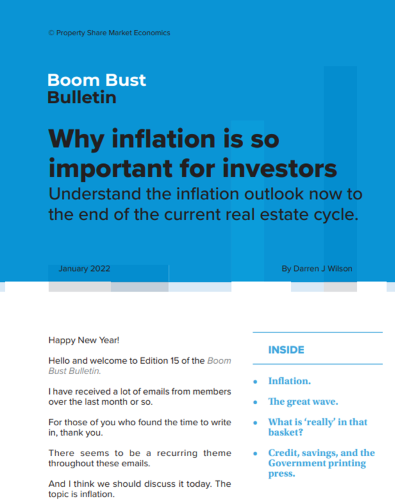If you would like to receive weekly updates like this, sign up here.
I just returned from a business trip to one of Australia’s busiest cities, Melbourne.
This was an opportunity to attend our first Property Sharemarket Economics (PSE) meet and greet event there since the Covid lockdowns.
We made it open to all current PSE, BBB and PCI newsletter members who happened to reside in Melbourne.
Perhaps you were there?
It was great to see and mingle with all the attendees. We had a lot of questions from those involved.
Certainly, the majority revolved around how best to prepare for the coming bust later this decade should the 18.6-year Real Estate Cycle repeat once again.
Good question to ask. Being prepared early would bring peace of mind and allow most of the emotion to be removed from the tough decisions such a bust would create.
But that’s not why I’m writing to you today.
In fact, it’s for the opposite reason. Clearly you need to have some plan in place for the time when the markets have a severe collapse.
But you shouldn’t allow such planning to blind you to the incredible amount of upside for markets that are still ahead of us.
I have written repeatedly the coming boom will dwarf all that went before it. I stand by that remark still.
Let me show you why I stand by that. In fact, I will return to this theme throughout 2023 via these weekly newsletters.
It is so important you are made aware of what the possible drivers of such a boom are.
My research, and those of others in the know, indicate that there are many. Sadly, and predictably, never reported by the mass media.
Read on now to discover how the greatest boom ever is likely to start.
Follow the money – LOTS of money.
We are now in a higher-than-normal inflation environment allied with aggressive interest rate raising from global central banks.
But what does that mean for you?
As a trader or investor, no matter your available capital or experience, the rules of the game have changed because of these dynamics.
In fact, it’s such an important distinction for you to make that it motivated me to write a Boom Bust Bulletin (BBB) edition back in January 2022.

Source – PSE
However, it’s not just everyday investors who need to change their strategy. The biggest hedge funds on earth have also changed their strategy. For precisely the same reasons too.
These are the guys, argubly the only ones, who can literally move markets when they pick up their phone and utter those famous instructions: “Buy!” or “Sell!”.
You cannot ignore what they do with their clients’ money.
So, what are they doing with it? Check out the following quote from a recent Financial Times article (the emphasis is my own).
Hedge funds are building their firepower in global macro trading as they seek to capitalise on the most lucrative environment since the financial crisis.
After years of dull returns in markets dominated by central bank stimulus, the sector has been turbocharged by sharp cuts in interest rates during the coronavirus pandemic and then the return of high inflation and steep rate rises as economies opened up.
Lets stop here for a moment. I need to explain to you the term ‘global macro trading’.
The financial website Investopedia explains this as follows:
A global macro strategy is a hedge fund or mutual fund strategy that bases its holdings primarily on the overall economic and political views of various countries or their macroeconomic principles. Holdings may include long and short positions in various equity, fixed income, currency, commodities, and futures markets.
The key here is the fact the current inflationary environment is primarily supply-side driven for now. To fight this, central banks globally have undertaken a fast and sustained interest rate rises.
This makes a big difference to things like national currencies that are freely floating and can be traded via forex exchanges.
And this is one of the biggest opportunities that have hedge funds building incredible amounts of capital from investors ready to go all-in.
Already the fight is on to secure the very best fund managers with US-based Schoenfeld, Graham Capital and Exodus Point among firms hiring in this space.
Managers are preparing for an expected influx of capital from investors searching for ways to protect their portfolios in an environment of choppy markets and diminishing support from central banks.
Graham Capital for instance has recently hired an economist, macro fund manager and are aggressively looking for more investment professionals.
Kenneth Tropin, chair of Graham Capital, recently stated,
“There’s been a paradigm shift in interest in macro from the previous decade to now, due in large part to central bank activity. Macro markets have been moving like crazy, last year was particularly good and the opportunity set is fantastic looking ahead.”
There is a deep and structural shift underway in markets.
Also in recruitment, as these hedge fund behemoths have caused an exceptionally high demand for experienced traders.
Since 2007, these macro funds have significantly underperformed relative to their peers as central banks responded to the 2008 financial crisis and slashed interest rates.
Central banks also flooded the monetary system with huge injections of liquidity which extinguished volatility.
Today, the groundwork has been laid for these same funds to outperform.
It’s not so much the “why?’ but “why now?” that matters.
And outperform they have. Considering the lackluster returns most investors (and their superannuation/401K accounts as well) were able to eke out, the difference is startling.
Funds on average gained 9 per cent last year, helped by soaring bond yields and a strengthening dollar, compared with a 17.7 per cent fall in the S&P 500 in total return terms and large losses suffered by many equity managers.
Among the biggest macro winners were Ken Griffin’s Citadel, which made 32.6 per cent in its fixed-income and macro fund (its best ever annual return), and Caxton Associates, whose macro fund gained 35 per cent.
Then there’s hedge fund Rokos, which gained more than 50 per cent and is up a further 6.5 per cent already this year, has opened to new money and is looking to grow its $15.5bn in assets under management by approximately $3bn as it aims to capitalise on the attractive trading opportunities.
This is big money. Here is what you need to know about it because these funds have used tens of billions of investor funds to make a statement.
High interest rates and higher than normal inflation is here to stay.
These funds don’t make such an enormous strategic pivot to simply chase a few months’ worth of gains.
They are in for good now. Their expectations are aimed at least for the remainder of this decade, perhaps beyond.
Does any of this speak of impending recession or depression to you?
We cannot experience the true peak to bust moment in markets until everyone is absolutely in and tapped out.
These funds have billions of dollars ready to invest and are fighting tooth and nail to attract even more than that. These hedge groups tend to move like herds, they can’t afford to not be following the dominant trend.
Otherwise, they risk below average returns.
So, macro trading strategy it is.
And if you have read any of my recent Property Cycle Investor (PCI) newsletters this year, you should be overlaying the 18.6-year Real Estate Cycle over this news.
And when you do, you’ll release we have just discovered one of many future drivers that align with our forecast for an almighty peak in asset markets later this decade.
So, what should you do with this information?
Get prepared and get educated is my advice. Here’s how, via a membership to the Boom Bust Bulletin (BBB). Give me the opportunity to take you in depth into the cycle.
Learn about the over 200-year history of the 18.6-year Real Estate Cycle and why even today it continues to repeat like clockwork.
It will teach you how to decipher the news that we get bombarded with every day to focus solely on what truly matters.
No more negativity and noise, just the science of the economic rent and the timing inherent in the real estate cycle.
This is all you need to succeed.
BNP Paribas found that macro was the best performing strategy last year. “Investors are particularly focused on the paradigm shift and what’s happening in rates and inflation,” said Marlin Naidoo, global head of capital introduction at the bank. “Macro is very well positioned to take advantage of that.”
Note what he said there: rates and inflation.
Then go back to the top of the newsletter: we were guiding our members on what they needed to know and how best to position themselves in a higher interest rate and inflation environment back in January 2022!
What else have we told our members since then?
And now, the biggest funds in the world are also positioning themselves for what’s to come.
As a Boom Bust Bulletin member you will receive 12 monthly editions a year detailing all the key turning points of the cycle, a deep dive into the most important markets across the globe and ways that you can personally benefit from this knowledge.
All derived from our unique and proprietary research – which you’ll not find anywhere else.
Plus, you’ll receive exclusive invites to BBB member-only webinars when we run them.
All this for just US $4 a month, less than a takeaway coffee.
Best wishes,

Darren J Wilson
and your Property Sharemarket Economics Team
P.S. – If you would like to receive weekly updates like this, sign up here.
P.P.S – Find us on Twitter here and go to our Facebook page here.
This content is not personal or general advice. If you are in doubt as to how to apply or even should be applying the content in this document to your own personal situation, we recommend you seek professional financial advice. Feel free to forward this email to any other person whom you think should read it.



